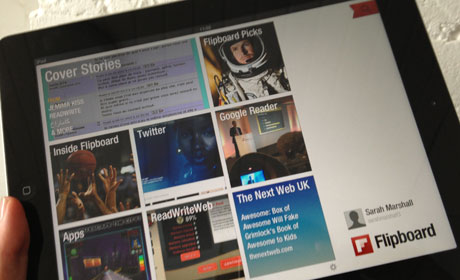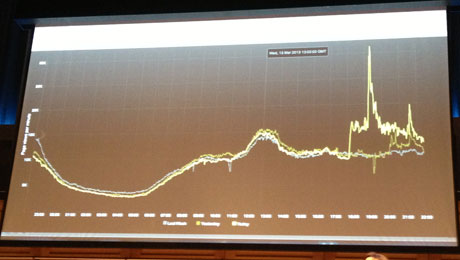
The challenge of publishing in a multiplatform world is like playing a 'five-level chessboard', says Lewis D'Vorkin
Credit: Image by ybot84 on Flickr. Some rights reservedHere is a round-up of some of the sessions that were relevant to news publishers from day one (21 March) of the Guardian Changing Media Summit 2013.
This summary outlines why Lewis D'Vorkin from Forbes sees the challenges of building a successful business model in a multiplatform world as playing a "five-level chessboard", how Flipboard is looking to further its relationship with publishers, and why the Guardian is "bullish" about revenue from mobile.
Content economics
The session on content economics looked at "maximising revenue in a converged world" and heard from the Metro, Bauer Media, and Forbes.
Linda Grant, managing director at Metro talked about how the free morning pick-up fills "smart boredom" time, providing content for people on the move.
Metro, which Grant said distributes 3.5 million copies of the newspaper a day, makes almost all of its revenue from print advertising, but also focuses on digital.
At the end of last year Metro announced its 'mobile-first' approach, launching a responsive, swipable site. Around the same time Metro switched to use WordPress VIP and is now the largest publisher using the CMS.
Grant also talked about the success of the Metro on Apple's Newsstand, and how a promotion which encouraged readers to scan QR codes and buy products resulted in 1,000 people doing so "despite all the hurdles" of downloading an app and entering credit card details.
Asked if the introduction of wifi at some London Underground stations had reduced the number of people reading Metro in print she said it had not.
Lewis D'Vorkin, chief product officer, Forbes Media talked about Forbes.com's digital publishing model, which was introduced in 2010.
"The media business in 2008/2009 was a train wreck – it needed to innovate," D'Vorkin said.
The Forbes.com approach to digital innovation is one of scale. It now publishes around 500 pieces of content a day and has an army of 1,000 'contributors': freelance journalists, academics and experts who write for the title, many of them getting paid a fee in relation to the amount of traffic they drive to the site.
And the "content at scale" model has resulted in a "massive" growth in traffic in the last two-and-a-half years – to 26 million monthly readers, according to D'Vorkin.
Last month we reported how Forbes.com reached 24.6 million unique visitors during January, an increase of 42 per cent on the same month last year.
Mobile is a significant traffic driver to Forbes (in November we reported mobile and tablets were providing 28 per cent of traffic). "Mobile is where it's at – not tablets," D'Vorkin told the conference, "and monetising mobile is one of the great challenges of the news business right now."Everybody is experimenting - anyone who isn't won't surviveLewis D'Vorkin, Forbes.com
He also talked about the launch the Forbes Magazine tablet app, which is not bundled in with the print edition so subscribers to the 96-year-old print title must pay extra for the digital edition. He said they are now "testing" and "experimenting" with various subscription models, suggesting this could change.
"Everybody is experimenting," D'Vorkin said. "Anyone who isn't won't survive."
And the greatest challenge for Forbes and other publishers? D'Vorkin described operating in a multiplatform world as one of playing a "five-level chessboard".
Paul Keenan, chief executive of Bauer Media, which publishes Grazia, Closer, and FHM, talked about how publishers need to better understand their audiences and how if they spend "too much time focusing/worrying about the problems of today" they "will miss the opportunities of tomorrow" (there is a helpful summary of Keenan's key points here).
Keenan said Bauer reaches 20 million people in the UK – and the key to success is producing "outstanding content".
He would not reveal how much the company is making from digital, but said the key is in diversification. "Unless you get incredible scale, you need to build multiple revenue streams."

Inside Flipboard
Mike McCue, founder and chief executive of Flipboard, a social magazine app for iPad, iPhone and Android, joined the conference via Skype.
Flipboard allows users to collect feeds from social web into one place. "It's almost a new kind of a web browser," he said.
The app is getting one new user every second, and has more than 20 million users, according to stats shared at the end of last year.
Although Flipboard launched as an iPad app before iPhone and Android versions were created, smartphone use has overtaken. McCue said two-thirds of readers are accessing Flipboard on a smartphone, one-third on a tablet.
More than half of Flipboard readers outside US, with the UK providing the second largest readership. Flipboard has also gone international, with versions for several different languages and last year launched in China.
Last week Flipboard responded quickly to news that Google was axing Google Reader. It published a blog post offering Reader users a "seamless transition".
McCue told the conference that 1.5 million Flipboard users have connected Google Reader accounts, and explained how Flipboard is "mirroring the API" so that those who connect Google Reader accounts before Google pulls the plug on 1 July will see their feeds automatically saved and available via Flipboard.
Flipboard also has a publisher programme and has plans to "bring more publishers into the Flipboard ecosystem", McCue said. "Publishers are great at creating content – and we want to work with them to make it work in mobile and to monetise."
And Flipboard can help publishers "engage with a younger audience", he said. "For publishers we enable content to look amazing, but we want to also help them bring in revenue."
Journalist and media commentator Kate Bulkley, who was chairing the conference, asked about the relationship that Flipboard has with publishers as Wired and the last year New Yorker moved away.
Both publishers decided to stop providing Flipboard-formatted content and selling ads through it, instead offering a single headline and linking to their respective websites. McCue predicted that both titles would return to Flipboard.
He also explained how Flipboard has partnered with the New York Times, integrating the subscription process so that those who pay for full access can read the entire New York Times within Flipboard.
Non-subscribers can read the top stories for free and users of the Android app can sign-up to subscribe to the New York Times via Flipboard. There are plans to introduce that function in the iOS apps. McCue said Flipboard would be rolling out the subscription option with other publishers "in the coming months".
Flipboard not only offers text-based content but already offers video and audio. McCue signalled that an increasing amount of video will be added, giving users "the ability to curate your own TV channel" around a niche interest and allowing them to be able to share that collection of content with other people.
"People want to consume in a seamless experience," McCue said, "and we are bringing together all the things you love."
Digital fitness
The closing panel of day one was on "digital fitness", and heard from Tanya Cordrey, chief digital officer, Guardian News & Media and Ralph Rivera, director, future media, BBC.
Cordrey talked about the Guardian's transition from a UK newspaper to a global publisher, with 78 million readers in February and "record mobile traffic", according to audited figures released yesterday.
"We've not done this by shamelessly chasing traffic, but through journalism."
She said the Guardian was the first publisher to announce that it was taking a digital-first approach, and "is the first newspaper looking more like an Apple, Google or Amazon."
She boldly claimed that the Guardian would be "the first newspaper to show that an open model will lead to financial sustainability".
She also said the Guardian was "very bullish" about revenues from mobile. App users "are much more engaged", she said. "They look at more content and come back more often".
Cordrey also shared a graph to illustrate a real-time analytics tool the Guardian has built in-house.
The below picture shows traffic to the Guardian over a 24-hour period on 13 March, with the day the new pope was announced with the traffic spike reflecting that news.

Ralph Rivera, director of future media at the BBC, talked about the success of the Olympics. "We wanted the Olympics to be for digital what the Coronation was for TV," he said.
And the Olympics "was social, very mobile, and local", with the torch relay involving local communities.
He said he sees a three-step process for media companies. Step one is "being digital", step two is "being connected" and step three is "being converged".
"So we have proved digital," he said, referring back to the success with the Olympics. "Now we need to connect to the 'people formerly known as the audience'," he added, borrowing a phrase used by Jay Rosen.
Videos of sessions from the conference are due to be added to the Changing Media Summit site next week. Other sessions of interest included a session on social analytics with speakers from the Independent, the Sun, Visual Revenue and the Weather Channel. Journalism.co.uk was moderating this session so we were unable to report.
Free daily newsletter
If you like our news and feature articles, you can sign up to receive our free daily (Mon-Fri) email newsletter (mobile friendly).
Related articles
- Five key takeaways from the UK select committee on the future of news
- How Reuters, Newsquest and BBC experiment with generative AI
- Standing out in a crowded market: what makes a top news podcast?
- Guardian launches a new section for readers in Europe
- How can UK commercial local news media respond to BBC expansion?









